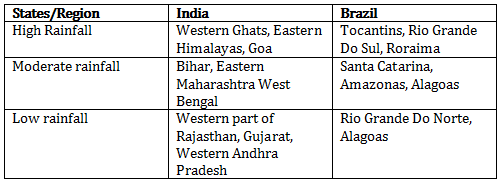Class 10 MAHARASHTRA STATE TEXTBOOK BUREAU Solutions Social Studies Chapter 4 - Climate
Climate Exercise 31
Solution 1

Solution 2 (a)
Right
Solution 2 (b)
Wrong. India and Brazil experience different seasons at the same time.
Solution 2 (c)
Right
Solution 2 (d)
Wrong. Brazil gets a lot of rainfall because of the southeast trade winds and Northeast trade winds.
Solution 3 (a)
The escarpment act as a barrier to the Southeast Trade winds giving rise to the rain- shadow area in the northeastern part of the highlands. The region to the north of this area is called 'Drought Quadrilateral'. Hence the northeastern part of Brazilian Highlands receives very less rainfall.
Solution 3(b)
Snowfall does not always occur in Brazil because a part of the Brazil lies in equatorial region and most parts lie in the tropical zone and hence temperature remains high for most of the year.
Solution 3(c)
Convectional rainfall mainly occurs in the equatorial regions. India lies in the tropical regions and have many high mountains and hills. It thus experiences orographic or relief rainfall and not convectional rainfall.
Solution 3 (d)
In the coastal regions of Brazil near the Equator, differences in temperatures are negligible. The winds move in the vertical direction in these regions. Also, the convergence zone of the trade winds is weak here. As a result, tropical cyclones occur rarely in Brazil.
Solution 3 (e)
Manaus is located to the north of Brazil and close to the Equator. This region receives perpendicular rays of the sun throughout the year. It also receives rainfall almost every day. Thus, the climate remains hot and humid throughout the year. Thus, there is not much difference in the range of temperature in Manaus.
Solution 3(f)
North-East Monsoon winds blow over land for most of the time in year and hence do not cause rainfall. It is only when it blow over the Bay of Bengal, these winds pick up moisture and bring rainfall over the Coromandel coast during the winter season.
Solution 4 (a)
- The Tropic of Cancer divides the country into almost two equal halves. The northern part of the country lies in subtropical zone while the southern part lies in the tropical zone.
- The Southern part of the country is a peninsula, hence it experiences equatorial climatic conditions as there is not much difference between the summers and winters.
- The Northern part of the country experiences sub-tropical climate which is surrounded by land. Hence it experiences continental type of climate as summers are extremely hot and winters are extremely cold.
Solution 4 (b)
- The Himalayas act as a barrier to the cold winds originating from central Asia and keeping the Northern Indian Plains warm.
- It also acts as a barrier to the moisture laden southwest Monsoon winds causing rainfall in the northern plains. Without the Himalayas, the Northern Indian plains would have been extremely cold and dry.
- High pressure conditions exist over the Indian ocean during summers while low pressure conditions exist over the Indian mainland.
- Winds blow from High pressure areas to low pressure areas. Hence southwest Monsoon winds blow from the Indian Ocean to the Indian mainland causing much needed rainfall over the country.
Solution 4 (c)
- Brazil experiences wide range of climatic variations due to its vast latitudinal extent, closeness to the Equator, presence of the Atlantic Ocean and the Great Escarpment.
- The northern part of Brazil near the Equator is hot, while temperate type of climate is found in the southern parts.
- Brazil gets rainfall from the South-East Trade Winds and the North-East Trade Winds blowing from the Atlantic Ocean.
- Convectional rainfall occurs in places near the equator. However, the Escarpment act as an obstruction to the winds blowing from the sea and cause orographic type of rainfall in the coastal region.
- Beyond the Highlands the effects of these winds get reduced, as a result the rainfall is minimal. This region is a rain-shadow region and is called 'The Drought Quadrilateral.'
- In the coastal regions near the Equator in Brazil, differences in temperatures are negligible. Because of the proximity to the sea, the coast experiences mild and humid climate.
Solution 4 (d)
Comparison between the climate of Brazil and India:
- Equator passes through Brazil while the Tropic of Cancer passes through India.
- India has a monsoon type of climate while Brazil experiences a wide range of climatic variations.
- The areas of Brazil lying in the equatorial regions have hot and humid climate while parts of southern Brazil experiences lower temperatures. In India, the southern parts experience high temperature throughout the year while the northern parts experience high temperatures during summers and extremely low temperature during winters.
- India receives rainfall mainly due to the Southwest monsoon winds and mostly the rainfall is of orographic type.
- Brazil receives orographic rainfall due to Southeast and North east trade winds. South Brazil experiences conventional type of rainfall in the Northern parts.

